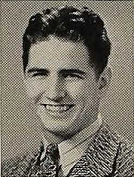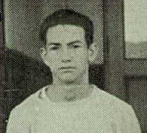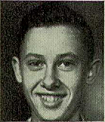The Tragic Story of "Kimball Hill"
- Will Armstrong

- Jul 29, 2019
- 7 min read
Updated: Jun 20, 2024
Marine Air Group 25 had been flying missions in support of the Guadalcanal Campaign for over a month when Maj. W. Frear Kimball, executive officer of VMJ-253, boarded his aircraft after midnight on October 9, 1942, to commence yet another supply run into the American perimeter. A TWA pilot in civilian life, Kimball had served in the Marine Corps Reserves before the war and was one of the core group of twelve highly experienced airline pilots who had been assigned to the newly formed group in June of that year.
Different accounts give various figures for the number of flying hours Kimball had logged by that date—8,000, maybe 10,000, all of them possibly exaggerated to some degree by his admiring squadron mates—but by all accounts his tally was impressive. To his peers, the 36-year-old San Francisco native was “Skip.” Kimball was to receive the Distinguished Flying Cross for his service during the Battle of Guadalcanal, which had included surviving an attack by a Nakajima A6M2-N "float Zero" on September 14. He was married and had a young daughter.
Kimball’s co-pilot that morning was 2nd Lt. Donald Eugene Griffin of Tehachapi, California, whose 28th birthday had ended less than an hour before boarding at Tontouta Air Base. When the United States entered the war, Griffin had been studying physics at UCLA.
The navigator was Cpl. J. Robert "Bobby" Troup, 25, of Goleta, California, who the Los Angeles Times described as “one of Santa Barbara’s outstanding horsemen.” Troup had studied at California Polytechnic, and worked as a foreman at Rancho Dos Pueblos prior to enlisting in March 1942.
Cpl. Charles Willard Mottram, Jr., age 20, was the flight mechanic. An Ohioan and star football player at Fostoria High School, he enlisted in June 1941 and had served in VMJ-152 before his assignment with VMJ-253.
Radio operator Pfc. C. David Vestal, 22, of Fairbury, Nebraska, had worked in an auto parts store and was a member of the Hastings College Class of 1944 prior to enlisting in February 1942.
Also aboard the flight were three members of VMSB-141, heading north to their unit on Guadalcanal. Sgt. Edward Frank Giczkowski of Buffalo, New York, age 21, was an SBD crew chief who had enlisted in 1940. Cpl. Harry Richard Merriner of Bellevue, Pennsylvania, age 18, was a mechanic who had graduated near the top of his class at the Aviation Machinist’s Mate School. Pvt. William F. Fromhold, Jr., of Cullman, Alabama, age 20, was also a mechanic.
Left to Right: David Vestal in 1941; Donald Griffin in 1931; Charles Mottram, Jr., in 1939.
Their aircraft that morning was Douglas R4D-1 Bureau Number 01981, one of the aircraft that had flown overseas with the group in September. The plane, almost certainly numbered “81” per group practice in the early months, was built under U.S. Army contract at the Douglas Long Beach Plant and delivered just months before the group’s deployment.

Seventy-seven years on, their cargo is a mystery, as are the precise weather conditions around Tontouta Air Base that morning, although multiple sources state that visibility was poor. What we do know is that at approximately 1:15 AM, Maj. Kimball’s aircraft plunged nearly vertically into the south side of Ouassio Hill, just under three miles from the end of the runway, killing all on board instantly. They were MAG-25’s first casualties and, their deaths having occurred over 1,000 miles from the end of their planned flight route at Henderson Field, they have become forgotten casualties of the Guadalcanal Campaign.

The loss of the crew was devastating, and the loss of Maj. Kimball in particular was felt throughout the group. If such a calamity could befall “Skip,” so it went, it could happen to anyone. The hill was forever after known as Kimball Hill to the men at Tontouta Air Base. Veteran pilots made a habit of showing the wreckage to new pilots as a cautionary warning: “Watch your altitude.”

Kimball Hill from the north-south runway at Tontouta Air Base. This runway is no longer extant.
Exactly what happened to Kimball’s aircraft remains unclear, but evidence indicates that the aircraft's starboard wing was severed from the aircraft, perhaps due to collision with terrain near the top of the hill or with a navigational beacon that may have been operating at the time. Both scenarios leave questions unanswered. The force of the collision appears to have flipped the rest of the aircraft over toward the south slope where it impacted nose down, inverted.
There are unconfirmed reports, including hearsay from later MAG-25 veterans, that Kimball lost an engine after takeoff, a deadly situation in an aircraft that was almost certainly overloaded with cargo and carrying the maximum load of fuel, and which would almost certainly have led to a fatal stall as they tried to maneuver around Ouassio Hill. Kimball may have been attempting to clear the top of the hill during the loss of power, and may have even seen the beacon if it was present and lit, and if visibility was not too poor. However we have found no concrete evidence to confirm the engine loss, and evidence may no longer exist given the condition of the wreck site.
To attempt to answer some of the questions surrounding the loss of 01981, I contacted Steven Hare, a fisheries biologist and hiking enthusiast who had documented other wrecks on New Caledonia. Steven graciously agreed to assist and led a team to the wreck site, where they compiled photographic documentation permitting a more thorough analysis of the accident. Further exploration by Steven and Paul Judd revealed still more details, especially regarding the possible role of the beacon tower. In 2024, Steven accompanied Ewan Stevenson to the wreck site, where Ewan collected still more photographic documentation.
Maj. Kimball’s aircraft still rests where it fell from the sky in October 1942, its wreckage distributed across a roughly triangular area. The starboard wing remains near the top of the hill. The smallest artifact field, consisting of internal structure from the starboard wing and the entire rear cargo door, lies approximately west-southwest of the starboard wing beyond the opposite side of the hilltop, in close proximity to the wreckage of a WWII-era navigational beacon and tower whose precise history is unknown at this time (it may have been installed after the accident). The rest of the aircraft is strewn across the south side of the hill.
The largest artifacts, constituting the main wreck site, are the nearly-intact aft fuselage area and the port wing, both upside down, and located roughly southwest of the starboard wing. The aft fuselage appears to have sheared off of the center wing section upon impact. The port wing shows evidence of having hit the ground head on, almost uniformly across its length. Little trace remains of the forward part of the aircraft (the largest artifact located to date is the cockpit "mail door"), and melted aluminum scattered south of the main wreck bears witness to the massive fire that consumed that part of the aircraft, fed by a full fuel load that likely included 200 to 400 additional gallons in auxiliary fuel tanks in the forward cargo area.
Whether the aircraft was carrying additional fuel drums or ordnance is unknown at this time, although at least one fuel drum is present at the wreck site. Although press accounts indicated that it carried “bombs and ammunition,” the wreck site shows no cratering, shrapnel damage, or other obvious signs of an ordnance explosion, although in his 2024 investigation Ewan Stevenson documented fire-damaged small arms ammunition (a common cargo) and several potential bullet holes.
Not yet located at the wreck site, and possibly melted in the fire or removed since the crash, are traces of either of the aircraft's propellers, which could have left clues about engine function. Only one engine remains at the site, and it is not clear whether it was part of the plane or merely cargo.
The crew and passengers of 01981 were interred the following day at the American cemetery in nearby Nouméa. The wreck became a pilgrimage site for Allied service personnel, some of whom etched their names on the wreck to pay their respects. When Headquarters Squadron 25 received its own R4D-5 the following year, for use by the SCAT and group commanders, the squadron assigned it the number “81.”
Kimball’s Distinguished Flying Cross, “for heroism and extraordinary achievement while participating in aerial flight, in actions against enemy Japanese forces,” was awarded posthumously. The crew also posthumously shared in the Presidential Unit Citation awarded to MAG-25 for its service during the Guadalcanal Campaign as part of the 1st Marine Division (Reinforced).
After the war’s end the crew and passengers of 01981 were repatriated to the United States, many, if not all, aboard the USAT Honda Knot, the first ship to bring home Pacific War casualties for reinterment.
For more information on the wreck site, click here.
This post will be updated with new information as it becomes available.
Special thanks to Steven Hare, Paul Judd, Dominique and "Petit" Dominique Dumortier, Roy Benyon, and Kanak guides Jerry and Camille for their outstanding work locating and documenting the wreck of R4D-1 01981. Thanks also to Ewan Stevenson, who visited the wreck with Steven Hare in 2024 and collected additional photographic documentation.

***
Information for this post was drawn from the muster rolls of VMJ-253 and VMSB-141; Individual Deceased Personnel Files from the National Personnel Records Center in St. Louis, as well as other U.S. government burial and casualty records; and the following published accounts:
“2 Marine Majors Honored by Halsey,” The San Francisco Examiner, June 23, 1943, 8.
“Body of Findlay Veteran Returned from Pacific Area,” Findlay Republican-Courier, October 11, 1947, 3.
“Charles Vestal dead; marine from Fairbury,” The Beatrice Times, October 28, 1942, 3.
“Fairbury Boy Killed,” Beatrice Daily Sun, October 15, 1942, 7.
“Fairbury Legion presents citations to parents,” Lincoln Journal Star, July 6, 1943, 2.
“Fostorian Killed In Pacific Crash,” Findlay Republican-Courier, October 15, 1942, 10.
“Hero Honored Posthumously,” The Los Angeles Times, June 27, 1943, 5.
“Heroism of Transport Pilot Given Praise Posthumously,” The Los Angeles Times, June 23, 1943, 17.
“Honored Dead of Allegheny County,” Pittsburgh Sun-Telegraph, May 30, 1943, 38.
Lundstrom, John B. The First Team and the Guadalcanal Campaign: Naval Fighter Combat from August to November 1942. Annapolis: Naval Institute Press, 1994, pp. 215-216.
“Navy Gives Casualty List,” The Los Angeles Times, October 27, 1942, 9.
“Noted Santa Barbara Horseman Loses Life,” The Los Angeles Times, October 15, 1942, 11.
Red and Black, Fostoria High School, 1939.
“S.F. Pilot’s Bravery Praised,” Oakland Tribune, June 22, 1943, 10.
The Bronco, Hastings College, 1941.
The Tomahawk, Tehachapi Valley Union High School, 1931.
“Up and Down California,” Santa Maria Times, October 17, 1942, 5.
“You’re In The Army Now!: Bellevue Marine Is Honor Man,” The Pittsburgh Press, July 3, 1942, 23.









Thanks for sharing this story!